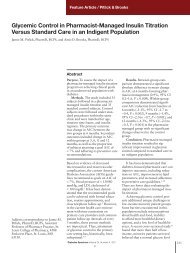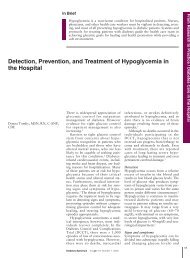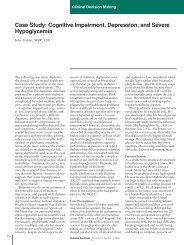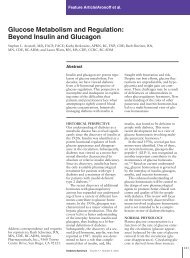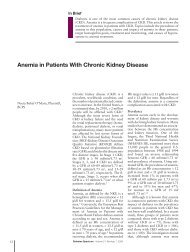Point-of-Care Testing in Diabetes Management: What Role Does It ...
Point-of-Care Testing in Diabetes Management: What Role Does It ...
Point-of-Care Testing in Diabetes Management: What Role Does It ...
Create successful ePaper yourself
Turn your PDF publications into a flip-book with our unique Google optimized e-Paper software.
immediate feedback <strong>of</strong> POCT. 8,9<br />
There is, however, limited research<br />
reflect<strong>in</strong>g the perspectives <strong>of</strong> HCPs<br />
and people with diabetes regard<strong>in</strong>g<br />
the role <strong>of</strong> POCT on diabetes management<br />
and the potential impact <strong>of</strong><br />
POCT on rout<strong>in</strong>e diabetes care. The<br />
purpose <strong>of</strong> this study was to explore<br />
ideas, op<strong>in</strong>ions, and expectations <strong>of</strong><br />
HCPs and people with diabetes about<br />
the potential role <strong>of</strong> POCT <strong>in</strong> diabetes<br />
management, specifically the impact<br />
<strong>of</strong> POCT on patient-provider <strong>in</strong>teractions<br />
and patient care, as well as<br />
issues <strong>of</strong> implementation.<br />
METHODS<br />
Sampl<strong>in</strong>g and Recruitment<br />
This study used the qualitative<br />
methodology <strong>of</strong> <strong>in</strong>-depth <strong>in</strong>terviews.<br />
Participants were purposefully chosen<br />
from five groups who were potential<br />
users <strong>of</strong> POCT for diabetes. These<br />
<strong>in</strong>cluded endocr<strong>in</strong>ologists, family<br />
physicians, family practice nurses, diabetes<br />
educators, and people with diabetes.<br />
A maximum variation sample<br />
<strong>of</strong> the health care pr<strong>of</strong>essionals was<br />
determ<strong>in</strong>ed by their practice location<br />
(urban/rural), practice size, and academic<br />
affiliation. 11 They were identified<br />
from exist<strong>in</strong>g membership lists or staff<br />
list<strong>in</strong>gs <strong>of</strong> local hospitals <strong>in</strong> southwestern<br />
Ontario, Canada. Potential<br />
participants who had diabetes were<br />
recruited from the local chapter <strong>of</strong> the<br />
Canadian <strong>Diabetes</strong> Association <strong>in</strong><br />
London, Ontario, Canada.<br />
The f<strong>in</strong>al sample size was determ<strong>in</strong>ed<br />
from the cont<strong>in</strong>uous analysis <strong>of</strong><br />
the <strong>in</strong>terviews and ceased once the<br />
researchers agreed they had reached<br />
theme saturation <strong>in</strong> that no new concepts<br />
or ideas were be<strong>in</strong>g <strong>in</strong>troduced<br />
by the participants. 11 Saturation was<br />
achieved <strong>in</strong> all five <strong>of</strong> the potential<br />
user groups listed above. Ethical<br />
approval was received from the ethics<br />
review board for health sciences<br />
research <strong>in</strong>volv<strong>in</strong>g human subjects at<br />
the University <strong>of</strong> Western Ontario.<br />
Data Collection<br />
The semistructured <strong>in</strong>terviews, conducted<br />
primarily <strong>in</strong> participants’<br />
<strong>of</strong>fices or homes, were audiotaped<br />
and lasted ~ 30 m<strong>in</strong>utes. The <strong>in</strong>terviews<br />
were conducted by either the<br />
project coord<strong>in</strong>ator or the research<br />
nurse. Interviewers explored the participants’<br />
ideas, op<strong>in</strong>ions, and expec-<br />
Feature Article/Brown et al.<br />
tations about the potential role <strong>of</strong><br />
POCT <strong>in</strong> diabetes management and<br />
the impact <strong>of</strong> POCT on patientprovider<br />
<strong>in</strong>teractions. For example,<br />
open-ended questions <strong>in</strong>cluded, “How<br />
would access to POCT <strong>in</strong>fluence your<br />
management <strong>of</strong> patients with diabetes?”,<br />
“<strong>What</strong> would be the impact<br />
<strong>of</strong> POCT on the <strong>in</strong>teraction with your<br />
patient?”, and “<strong>What</strong> would be the<br />
impact <strong>of</strong> POCT on your compliance<br />
with physician or nurse recommendations?”<br />
The audiotapes were transcribed<br />
verbatim and transferred <strong>in</strong>to<br />
the NUD*IST qualitative s<strong>of</strong>tware<br />
program. 12<br />
Data Analysis<br />
Immersion and crystallization analysis<br />
strategies were used. 13 This required<br />
that all <strong>of</strong> the researchers (J.B.B.,<br />
S.B.H., S.W.B., and S.P.) read all the<br />
transcripts <strong>in</strong>dependently, identify<strong>in</strong>g<br />
key phrases or concepts used by the<br />
participants dur<strong>in</strong>g the <strong>in</strong>terviews.<br />
They then met to compare and contrast<br />
their <strong>in</strong>dividual f<strong>in</strong>d<strong>in</strong>gs and thus<br />
clarify and expand the themes.<br />
Discussions ensued until consensus<br />
was reached. Next, patterns, categories,<br />
and themes emerg<strong>in</strong>g from the<br />
<strong>in</strong>terviews from each participant<br />
group and across all groups were<br />
exam<strong>in</strong>ed us<strong>in</strong>g the qualitative s<strong>of</strong>tware<br />
program noted above. This<br />
aided <strong>in</strong> clarify<strong>in</strong>g the most prom<strong>in</strong>ent<br />
themes and secur<strong>in</strong>g the most relevant<br />
quotes for illustration. The analysis<br />
was deemed complete when there<br />
were no new themes emerg<strong>in</strong>g, aga<strong>in</strong><br />
based on hav<strong>in</strong>g reached saturation. 11<br />
Authenticity<br />
Credibility <strong>of</strong> the data was established<br />
by audiotap<strong>in</strong>g and transcrib<strong>in</strong>g all <strong>of</strong><br />
the <strong>in</strong>terview data verbatim, ma<strong>in</strong>ta<strong>in</strong><strong>in</strong>g<br />
field notes, and systematic <strong>in</strong>dividual<br />
and team analysis. The multidiscipl<strong>in</strong>ary<br />
composition <strong>of</strong> the research<br />
team also enhanced the credibility <strong>of</strong><br />
the analysis and <strong>in</strong>terpretation <strong>of</strong> the<br />
data.<br />
FINDINGS<br />
A total <strong>of</strong> 37 <strong>in</strong>terviews were conducted.<br />
These <strong>in</strong>cluded <strong>in</strong>terviews with<br />
seven family physicians (four urban<br />
and three rural), five endocr<strong>in</strong>ologists<br />
(five urban), two <strong>in</strong>ternists (one rural,<br />
one urban), eight diabetes educators<br />
(five urban, three rural), seven family<br />
practice nurses (four urban, three<br />
<strong>Diabetes</strong> Spectrum Volume 17, Number 4, 2004<br />
rural), and eight people with diabetes<br />
who all dwelled <strong>in</strong> an urban community.<br />
Two major themes emerged reflect<strong>in</strong>g<br />
the participants’ ideas, op<strong>in</strong>ions,<br />
and expectations about POCT. One<br />
theme was the impact <strong>of</strong> POCT on the<br />
cl<strong>in</strong>ical encounter and the care <strong>of</strong><br />
patients. The other theme was specifically<br />
on the POCT mach<strong>in</strong>e, <strong>in</strong>clud<strong>in</strong>g<br />
accuracy and the cost <strong>of</strong> <strong>in</strong>corporat<strong>in</strong>g<br />
the mach<strong>in</strong>e <strong>in</strong>to cl<strong>in</strong>ical practice. <strong>It</strong><br />
was apparent <strong>in</strong> the analysis that there<br />
were strong similarities across all <strong>of</strong><br />
the HCP groups, and, consequently,<br />
they are reported as a common voice.<br />
While participants who had diabetes<br />
also expressed similar perspectives,<br />
with<strong>in</strong> each subsection reported below<br />
they are reported as a separate group<br />
and are referred to as patients given<br />
the cl<strong>in</strong>ical context.<br />
Impact <strong>of</strong> POCT on Cl<strong>in</strong>ical <strong>Care</strong><br />
All <strong>of</strong> the participants acknowledged<br />
the valuable impact <strong>of</strong> POCT on the<br />
cl<strong>in</strong>ical care <strong>of</strong> patients with type 2<br />
diabetes. The <strong>in</strong>formation provided by<br />
POCT was viewed as immediate, convenient<br />
for all <strong>in</strong>volved, and an aid to<br />
cl<strong>in</strong>ical decisions for diabetes management.<br />
Participants perceived the<br />
receipt <strong>of</strong> the <strong>in</strong>formation <strong>in</strong> a face-t<strong>of</strong>ace<br />
manner as enhanc<strong>in</strong>g the patientprovider<br />
<strong>in</strong>teraction, as characterized<br />
by improved communication, opportunities<br />
for patient education, and<br />
ultimately <strong>in</strong>creased patient adherence.<br />
Further detail on each <strong>of</strong> these<br />
components <strong>of</strong> the cl<strong>in</strong>ical encounter<br />
are described below.<br />
Immediacy <strong>of</strong> results. Participants<br />
endorsed immediacy <strong>of</strong> results as the<br />
greatest advantage <strong>of</strong> POCT and<br />
viewed it as enhanc<strong>in</strong>g cl<strong>in</strong>ical care. A<br />
typical sentiment, as one HCP<br />
expressed it, was that, “Immediate<br />
answers are <strong>in</strong>credibly important to<br />
patients these days . . . so it is sometimes<br />
not acceptable for them to wait<br />
3–4 weeks to get a result <strong>of</strong> a microalbum<strong>in</strong>.”<br />
Participants said that the immediate<br />
results allowed HCPs to “strike<br />
while the iron is hot” and to “decide<br />
on a management change potentially<br />
right then and there.” Be<strong>in</strong>g able to<br />
recommend specific changes was perceived<br />
as more efficient and thorough.<br />
“<strong>It</strong> makes the process more efficient <strong>in</strong><br />
terms <strong>of</strong> recommendations you’re<br />
go<strong>in</strong>g to make to the person and to<br />
245



